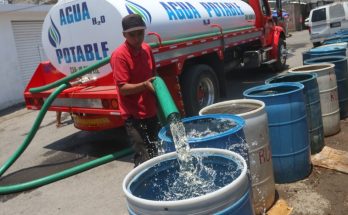By Alejandro Angulo
Different reports have emerged regarding the current water situation in Peña de Bernal. Many are conflicting, but there is one thing in common – they all report a water problem in one of the state’s emblematic tourist sites. According to some sources there is no longer any water in the wells that supply our town. Others report that the amount of water is not sufficient even though it continues to be extracted from said well. It is also reported that there is an excess in the population and that this is what is causing the scarcity of water.
Peña de Bernal, located within the Tequisquiapan Valley Aquifer, has an area of 640.63 km2, as defined by code 2205 in the Geographic Information System for Groundwater Management (SIGMAS) of CONAGUA. It is in the central part of the state of Querétaro, encompassing the municipalities of Tequisquiapan, Ezequiel Montes and Colón.
The current water status in Peña de Bernal may be due to the fact that the Valle de Tequisquiapan aquifer has had a low average annual rainfall of 425.47 mm for the past several years. It also has a high evaporation potential, which means that most of the precipitated water evaporates, thereby reducing runoff and infiltration.
In addition, what must be considered is the increase in water demand because of the continued increase in population, which grows at an approximate rate of 2.05% per annum. Data shows that the total water extraction is 118.0 Mm3 per year while the recharge received by the aquifer is 108.1 Mm3 per year.
Continued economic activities, mainly in the tourism sector, and the limited availability of groundwater in the aquifer could generate competition for this resource among different users. Due to intensive groundwater exploitation this implies the risk of negative effects both for the environment and for the users of this resource. This could become a future pattern.
The increase in demand for groundwater will aggravate the harmful effects caused by intensive exploitation, such as the deepening of extraction levels, some wells becoming unusable, the increase in pumping costs, the decrease and even disappearance of springs and baseflow, and the deterioration of groundwater quality.
Prevention of overexploitation is not enough because we now have water imbalance and environmental deterioration. This impacts socioeconomic activities dependent on groundwater in the municipality of Ezequiel Montes. This area has a number of surface water bodied and the main source of water supply for Peña de Bernal is groundwater.
There are 308 wells registered in the valley which extract an average annual volume of 118 Mm3. As of February 20, 2020 the volume of groundwater extraction is 108,065,650 Mm3 per year, as reported by the Public Registry of Water Rights (REPDA) of the General Offices of Water Administration. Of the 308 wells, 220 are assigned to agricultural use and 88 for urban use. A subsequent study shows there are 456 underground water collection centers, of which 345 are assigned to agricultural use, 94 to urban/public use, and 17 to livestock use. The estimated total volume extracted through wells is 118.0 Mm3 per year. The greatest portion of this, 107.3 Mm3 per year, is destined for agricultural use. Only 6.8 Mm3 per year is destined for urban/public use and 3.9 Mm3 per year for livestock use.
According to the National Water Commission there is no available volume to grant new concessions. There is, instead, a deficit of 2,565,650 Mm3 per year that is being extracted at the expense of non-renewable storage of the aquifer. Therefore, the water deficit, the overexploitation of groundwater, the concentration of a larger population, the increase in economic activities such as tourism, and the irrationality of water consumption are all a problem. We can now add the fact of a dry season in the region, which is the current situation.
Talking about running out of water is relative because if we look at the case of Bernal, a set of elements come together that cause water collapse. Were it not due to population increase, growth in economic activities, and the irrational consumption of water beyond what exists and is available we would not be in the current scenario of Peña de Bernal.
The possibility of opening another well is not exactly the required solution. Instead of continuing to drill more wells and extract water without any limit to plan according to the volume of water that we currently have, now is the time to establish a water development and consumption plan below the current one, based on current water availability.




